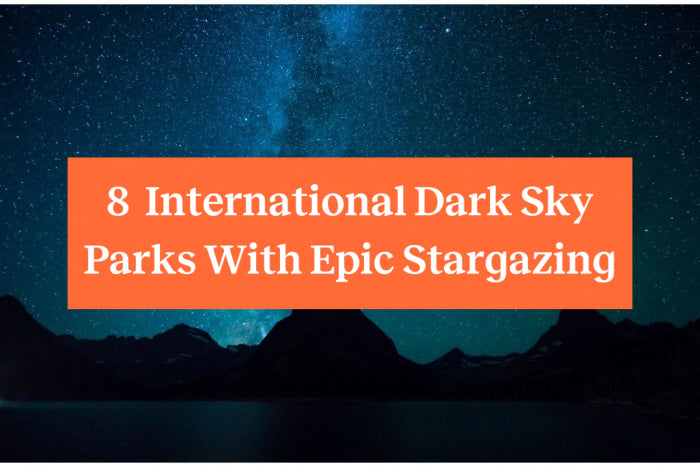
Desde tu patio trasero, ¿aproximadamente cuántas estrellas crees que puedes ver en las noches más claras? ¿1000? ¿Algunos miles? En realidad, son solo unas 500, más o menos.
En marcado contraste, ¡se pueden ver hasta 15.000 desde los Parques Internacionales de Cielo Oscuro!
La Asociación Internacional de Cielo Oscuro (IDA) define un Parque Internacional de Cielo Oscuro como “un terreno que posee una calidad excepcional o distinguida de noches estrelladas y un ambiente nocturno que está específicamente protegido por su patrimonio científico, natural, educativo, cultural y/o disfrute público”.
Hay un poco más de 100 parques internacionales de cielo oscuro en todo el mundo, menos de 80 de ellos en Estados Unidos (¡y solo un puñado son parques nacionales !).
Estos parques protegen mucho más que “sólo” cielos oscuros; la oscuridad es crucial para la supervivencia de muchas especies vegetales y animales, además de ser importante para los ritmos circadianos naturales de los humanos.
¿A dónde puedes ir para contemplar paisajes nocturnos asombrosos y aprender más sobre la importancia de los cielos nocturnos despejados y oscuros? Aquí te presentamos ocho de nuestros parques internacionales de cielo oscuro favoritos.
Observa las estrellas en estos parques internacionales de cielo oscuro
¿Preferirías visitar uno de los parques nacionales más emblemáticos del mundo, o te gusta más un bosque remoto en Maine?
De cualquier manera, estos ocho parques internacionales de cielo oscuro ofrecen una observación de estrellas impresionante.
1. Parque Nacional Big Bend, Texas
Todos los parques internacionales de cielo oscuro de esta lista son de visita obligada, pero el Parque Nacional Big Bend en el sur de Texas es uno verdaderamente destacado.
Tiene el honor de ser el más oscuro de todos los parques nacionales de los 48 estados inferiores, lo que significa que tiene la menor cantidad de contaminación lumínica medible.
Como puedes imaginar, Big Bend es uno de los mejores parques internacionales de cielo oscuro para observar las estrellas.
El NPS ofrece varios programas con temática astronómica durante todo el año, que incluyen caminatas a la luz de la luna y fiestas de estrellas, pero también puede tener una maravillosa experiencia de observación de estrellas simplemente trayendo una silla de jardín y poniéndose cómodo bajo el cielo nocturno durante unas horas.
¿Necesitas una razón más para visitar Big Bend? El parque tiene otra característica increíblemente única: se encuentra directamente en la frontera entre Estados Unidos y México, y el Río Grande es la frontera internacional “oficial”.
2. Parque estatal Cherry Springs, Pensilvania
El parque estatal Cherry Springs, en el norte de Pensilvania, es considerado por muchos como “uno de los mejores lugares de la costa este para observar las estrellas y la ciencia de la astronomía ”. Esto se debe en gran medida a su naturaleza aislada y salvaje: el parque está rodeado por el bosque estatal Susquehannock de más de 260.000 acres.
Sin embargo, su geografía no es la única razón por la que Cherry Springs es uno de los mejores parques internacionales de cielo oscuro para observar las estrellas. El parque no tiene una, sino dos áreas dedicadas a la observación astronómica.
Está el Área Pública de Observación del Cielo Nocturno, destinada a salidas de observación de estrellas más cortas de unas pocas horas aproximadamente, así como el Campo de Observación Astronómica Nocturna.
Ambas áreas ofrecen vistas panorámicas del cielo desde la cima de una montaña y están abiertas literalmente siempre. Sin embargo, es necesario obtener unGalaxy Pass para utilizar el campo de observación nocturno. Los pases están disponibles en enero y, por lo general, se agotan rápidamente.
3. Parque Nacional Glaciar, Montana
El Servicio de Parques Nacionales tiene un dicho para Glaciar: “¡La mitad del parque está ocupado después del anochecer!”
Esto significa que el parque ofrece programas educativos y de observación del cielo nocturno para conectar literalmente a la gente con las estrellas. La mayoría de los programas se llevan a cabo durante el verano, pero también se realizan fiestas de estrellas en Logan Pass en función del tiempo.
Para disfrutar de los mejores miradores, diríjase a uno de los lagos. Debido a que Glacier es tan montañoso y presenta terrenos y elevaciones variables, algunas áreas están demasiado cubiertas de bosques como para poder ver gran parte del cielo nocturno. Los lagos, en particular Swiftcurrent, St. Mary y Lake McDonald, ofrecen áreas de observación más abiertas.
Si tienes suerte y el momento es el adecuado, ¡quizás incluso puedas ver la aurora boreal!
Tenga en cuenta que muchos de los caminos de Glaciar y algunas de las entradas del este cierran por completo durante los meses de invierno debido al clima extremo.
4. Parque de cielo oscuro internacional Headlands, Michigan
La península superior del norte de Michigan, o “UP”, es conocida por ser una zona silvestre prístina y pintoresca. Desde muchos lugares de la península superior, se pueden ver con frecuencia las constelaciones completas, la Vía Láctea e incluso la aurora boreal.
Sin embargo, uno de los mejores destinos para ver estas maravillosas vistas es Headlands International Dark Sky Park, uno de los parques internacionales de cielo oscuro designados más antiguos de los Estados Unidos.
Headlands se encuentra directamente en la costa norte del lago Michigan y es un parque completamente subdesarrollado. De hecho, el parque abarca más de dos millas de costa no desarrollada del lago Michigan.
Eso significa que prácticamente no hay contaminación lumínica que interfiera con la observación de las estrellas. Y lo que es mejor, el cielo nocturno entero suele reflejarse perfectamente en las brillantes aguas del lago.
El parque está abierto las 24 horas del día, los 7 días de la semana, los 365 días del año y, mejor aún, la entrada siempre es totalmente gratuita.
5. Monumento Nacional de los Puentes Naturales, Utah
Se podría decir (con precisión) que Natural Bridges es el OG. Fue el primer Parque Internacional de Cielo Oscuro del mundo entero, obteniendo la designación en 2007.
Al preparar el camino para todos los parques internacionales de cielo oscuro que vendrán, Natural Bridges demuestra que las pequeñas cosas llegan muy lejos.
Por ejemplo, todas las luces exteriores tienen protectores que apuntan la luz hacia el suelo, para mayor seguridad al caminar de noche. También se utilizan luces con detector de movimiento siempre que es posible, para minimizar la cantidad de luz artificial emitida.
Estas “pequeñas cosas” han dado como resultado uno de los destinos más oscuros, limpios y claros de la Tierra para observar las estrellas. Puedes explorar con seguridad cualquier área del parque por la noche, pero ten en cuenta que tendrás que alejarte de los campamentos y los estacionamientos para tomar fotografías de los icónicos puentes naturales.
Si se dirige a Natural Bridges para observar las estrellas, considere hacer un viaje por carretera a los parques nacionales : Canyonlands, Arches y Capitol Reef se encuentran a poca distancia en automóvil.
6. Monumento Nacional Bosque y Aguas Katahdin, Maine
Es posible que hayas notado que la mayoría de los parques internacionales de cielo oscuro de esta lista se encuentran en la mitad occidental de los Estados Unidos. Esto se debe principalmente a que el oeste generalmente tiene MUCHAS más tierras públicas abiertas.
Sin embargo, eso no significa que no haya algunos parques internacionales de cielo oscuro increíbles en el este. De hecho, el Monumento Nacional Katahdin Woods and Waters (técnicamente un santuario internacional de cielo oscuro, ¡y solo el duodécimo en el mundo!) alberga los cielos más oscuros al este del río Misisipi.
Según Friends of Katahdin Woods & Waters , los cielos del monumento tienen una escala de 2 en la escala Bortle, lo que indica que “solo lugares tan remotos como la Antártida tienen cielos más oscuros”. ¡No hace falta decir que aquí encontrarás algunos de los mejores lugares para observar estrellas del mundo!
Para disfrutar de las mejores oportunidades de observación, diríjase a Haskell o Big Spring Brook Huts, o al mirador de Katahdin Loop Road.
7. Parque Nacional del Bosque Petrificado, Arizona
Dato curioso: Arizona tiene nada menos que 19 comunidades de cielo oscuro internacionales designadas oficialmente, dos de las cuales son parques nacionales (el Gran Cañón es el otro).
La ciudad de Flagstaff fue de hecho el primer Lugar Internacional de Cielo Oscuro, lo que ayudó a iniciar un importante movimiento para proteger los cielos excepcionalmente claros y oscuros del suroeste.
Si bien el Bosque Petrificado es uno de los parques nacionales menos conocidos y no está asociado con la aventura de la misma manera que, por ejemplo, Yosemite , aún así merece un lugar cerca del tope de tu lista de deseos, especialmente para observar las estrellas.
El espectacular cielo nocturno ofrece un telón de fondo brillante para el paisaje antiguo y casi sobrenatural del Bosque Petrificado. Y, además, ¡las puestas de sol en el desierto del parque son asombrosas! Así que traiga algunas sillas y una cena tipo picnic, acomódese justo antes del atardecer y póngase cómodo.
8. Reserva Nacional Valles Caldera, Nuevo México
Valles Caldera, uno de los parques internacionales de cielo oscuro más nuevos, en el norte de Nuevo México, obtuvo su designación en febrero de 2021.
El paisaje y la historia de Valles Caldera son únicos y fascinantes por sí mismos; el fenomenal cielo nocturno es solo la guinda del pastel.
Hace más de un millón de años, una erupción volcánica masiva creó la caldera de 21 kilómetros de ancho, formando extensas praderas, montañas suavemente onduladas, bosques de pinos antiguos e innumerables arroyos salvajes. Hoy, la reserva es el hogar de una fauna diversa, incluidas manadas de alces y pavos salvajes.
Explora todo esto durante el día y luego quédate por la noche para disfrutar de una de las mejores observaciones de estrellas y astrofotografías del mundo. Los mejores puntos de observación (que también son de fácil acceso) son los apartaderos a lo largo de la Ruta Estatal 4 de Nuevo México.
Debido a que Valles Caldera es un Parque Internacional de Cielo Oscuro recientemente designado, los programas de astronomía aún están en desarrollo. El parque planea ofrecerlos desde mayo hasta septiembre de 2022.
¿Has estado en alguno de estos parques internacionales de cielo oscuro o tienes otras sugerencias que no te puedes perder?
Independientemente de cuáles hayas visitado y cuáles estén ahora en tu lista de deseos, una forma fantástica de homenajearlos es con un recuerdo de viaje único. ¡Echa un vistazo a los vales de viaje y los portavalijas de The Wander Club!
Ofrecemos fichas de parques nacionales de EE. UU. , fichas de estados y países, monumentos e incluso creaciones completamente personalizadas. ¡Obtenga la suya hoy y comience a planificar su próxima aventura de observación de estrellas!


















































